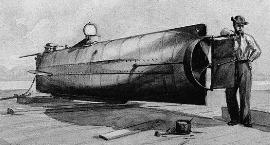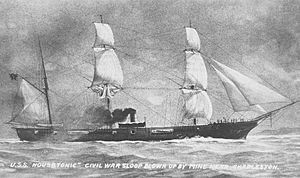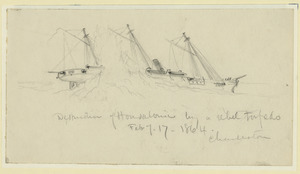Sinking of USS Housatonic facts for kids
Quick facts for kids Sinking of USS Housatonic |
|||||||
|---|---|---|---|---|---|---|---|
| Part of the American Civil War | |||||||
 A drawing of H.L. Hunley by R.G. Skerrett. |
|||||||
|
|||||||
| Belligerents | |||||||
| Commanders and leaders | |||||||
| Strength | |||||||
| 1 sloop-of-war | 1 submarine | ||||||
| Casualties and losses | |||||||
| 5 killed 1 sloop-of-war sunk |
8 killed 1 submarine sunk |
||||||
The Sinking of USS Housatonic happened on February 17, 1864, during the American Civil War. This event was a big moment in naval warfare, which is fighting at sea. A Confederate Navy submarine called H.L. Hunley attacked a Union Navy warship.
The H.L. Hunley made a secret night attack on USS Housatonic in Charleston harbor. The submarine moved just under the water's surface. It was not seen until the very last moments. It then attached and exploded a special bomb called a spar torpedo. This quickly sank the 1,240 long tons (1,260 t) sloop-of-war, and five Union sailors died.
The H.L. Hunley became famous as the first submarine to successfully sink an enemy ship in battle. It was a key step for what became modern submarine warfare. However, the victory was short-lived. The submarine did not survive the attack and was lost with all eight Confederate crew members.
The Attack: Sinking of the Housatonic
On the evening of February 17, 1864, the H.L. Hunley went on its first mission. It carried a spar torpedo attached to a long pole at its front. The submarine's goal was to help end the blockade of Charleston, South Carolina. It planned to destroy the Union ship USS Housatonic in Charleston Harbor.
The Housatonic was a large ship, about 1,240-long-ton (1,260 t) in size. It had twelve big cannons. The ship was stationed about five miles (8.0 km) off the coast, at the entrance of Charleston Harbor. Captain Charles W. Pickering commanded the Housatonic, which had a crew of 150 men.
The H.L. Hunley began its approach around 8:45 pm. First Lieutenant George E. Dixon was in command, with seven volunteer crew members.
Exactly how the H.L. Hunley approached is not fully known. But it was spotted just before it attached its torpedo to the Housatonic's hull. Reports say the Housatonic could not fire its main cannons at the submarine. It only hit the H.L. Hunley with small guns. The H.L. Hunley attached its explosive to the Housatonic's side. Then, it turned around and headed back.
A few moments later, the torpedo exploded. The Housatonic began to sink quickly. Crew members on the Housatonic did not hear an explosion. They immediately started climbing the ship's ropes or getting into life boats. The ship began to sink from the back and tilt to one side. Within five minutes, the Housatonic was partly underwater. This made the H.L. Hunley the first submarine to sink a warship in battle.
What Happened Next: The Aftermath
Five Union men, two officers and three sailors, died with their ship. Other Union Navy sailors were injured. Survivors were later rescued by other ships from the Charleston blockade. The first ship to arrive was USS Canandaigua.
The H.L. Hunley won its first victory. However, it was lost at sea the same night. It was on its way back to Sullivan's Island.
For a long time, people thought the H.L. Hunley sank because its own torpedo exploded. But some people now believe it survived for up to an hour after destroying the Housatonic. This idea is supported by a report from the commander of Fort Moultrie. He said that signals from the submarine were seen and answered. Also, a lookout on the sunken Housatonic reported seeing a "blue light." This "blue light" was a special signal used by the US Navy at that time.
This was the last time anyone heard from the H.L. Hunley. It was later found in the waters off Charleston, South Carolina. The reason for its sinking on the way back is still not fully known.
In 2013, archaeologists found new evidence. They believe the H.L. Hunley was less than 20 feet (6.1 m) away from the explosion. This was much closer than thought before. The explosion likely damaged the submarine and its target. Later studies suggested the crew might have died instantly from the blast. However, this is still being discussed by experts.



